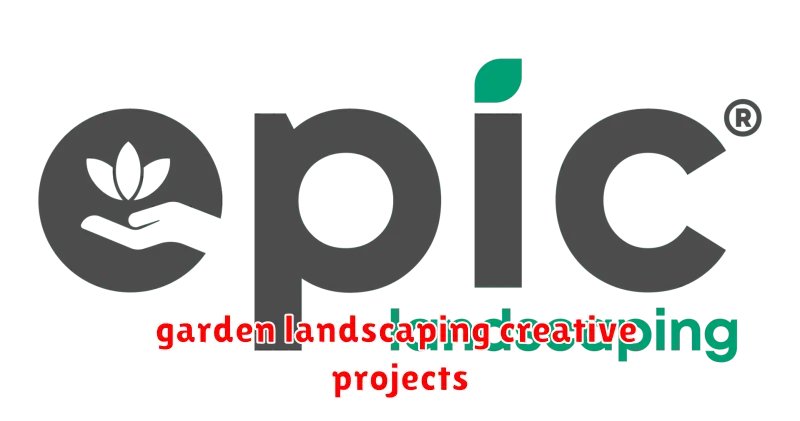Transform your outdoor space into a breathtaking oasis with these creative garden landscaping projects. Whether you’re seeking unique design ideas for a small backyard or grand plans for a sprawling property, this article offers inspiration for every skill level and budget. Discover innovative ways to incorporate water features, vertical gardens, and eco-friendly landscaping techniques. Unleash your creativity and learn how to craft a truly personalized garden design that reflects your style and enhances your home’s curb appeal. Explore DIY landscaping tips and professional garden design advice to turn your vision into a stunning reality.
DIY Garden Pathways

Creating DIY garden pathways offers a budget-friendly and personalized approach to landscaping. Numerous materials can be utilized, including readily available options such as gravel, flagstones, or reclaimed wood. Proper planning, including considering the pathway’s function and the surrounding landscape, is crucial for a successful outcome.
The construction process itself is often straightforward, depending on the chosen material. For instance, laying gravel involves creating a base layer and then distributing the gravel evenly. Flagstone pathways necessitate more precision, requiring careful placement and potentially some leveling of the ground. Careful consideration should be given to drainage to prevent water accumulation.
Beyond the practical aspects, DIY pathways allow for considerable creative freedom. Adding decorative elements such as plants, edging, or lighting can elevate the pathway’s aesthetic appeal and seamlessly integrate it with the overall garden design. The result is a functional and visually pleasing addition to any outdoor space, reflecting individual style and enhancing the garden’s beauty.
Natural Stone Water Features
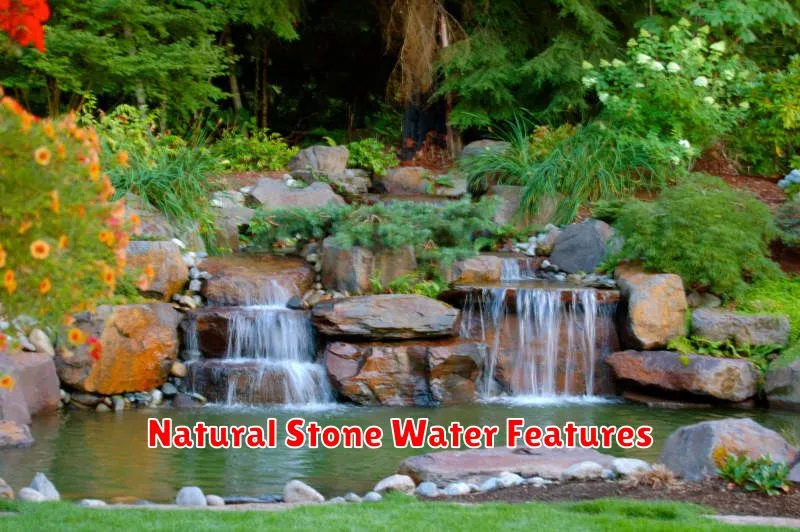
Natural stone water features offer a timeless and elegant addition to any garden landscape. The use of materials like granite, slate, or river rock creates a visually appealing and naturally calming environment. These features can range from small, bubbling fountains to elaborate ponds and waterfalls, offering a variety of sizes and styles to suit any garden design.
The durability and natural beauty of stone make it an ideal material for outdoor water features. Stone’s resistance to weathering ensures longevity, while its varied textures and colors provide endless design possibilities. Furthermore, the sound of gently flowing water adds a soothing ambiance, enhancing the overall serenity of the garden.
When designing a natural stone water feature, consider integrating it seamlessly with the existing landscape. The choice of stone should complement the surrounding plants and hardscaping. Proper planning and installation are crucial to ensure both aesthetic appeal and long-term functionality. The inclusion of appropriate pumping systems and filtration is essential for maintenance.
Solar-Powered Garden Lamps
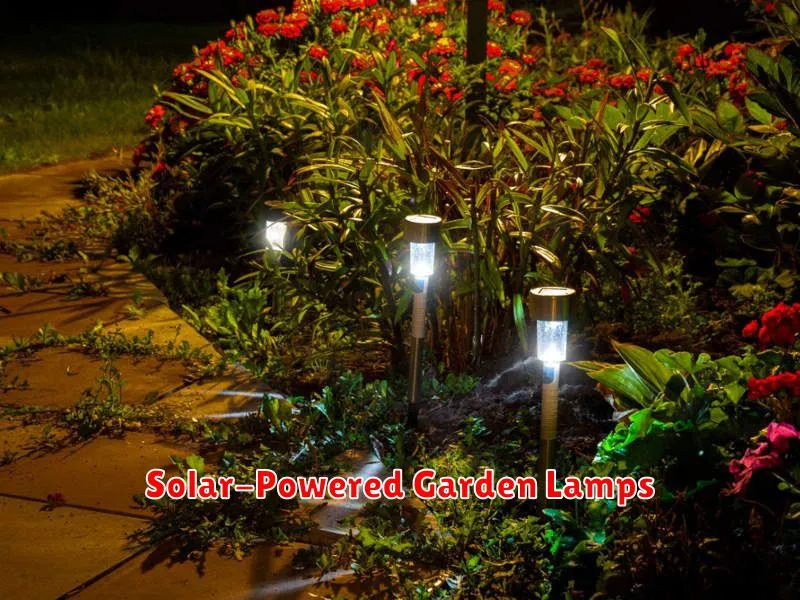
Solar-powered garden lamps offer a sustainable and aesthetically pleasing way to illuminate your outdoor space. These lamps harness the sun’s energy during the day, storing it in rechargeable batteries to provide ambient lighting at night. This eliminates the need for electrical wiring, making installation simple and cost-effective.
A wide variety of styles are available, ranging from classic designs to modern, minimalist options. Consider the overall aesthetic of your garden when selecting lamps. Factors such as material (e.g., metal, plastic, glass), size, and light color temperature will impact the final look and feel.
Beyond aesthetics, practical considerations include brightness, run time, and durability. Check the specifications to ensure the lamps meet your lighting needs and can withstand weather conditions. Proper placement is also crucial for optimal solar energy absorption and effective illumination of your garden paths and features.
Hanging Flower Baskets

Hanging flower baskets offer a versatile and visually appealing addition to any garden landscaping project. Their placement allows for the creation of vertical gardens, maximizing space utilization, particularly in smaller areas. A wide variety of plants, from trailing petunias to vibrant geraniums, can be used to achieve different aesthetic effects, adding texture and color to otherwise plain walls or fences.
The selection of the right basket is crucial. Consider the size and weight capacity to accommodate the mature plants. The material of the basket should also be chosen carefully, considering factors like drainage and durability. Proper planting techniques, including the use of high-quality potting mix and regular watering, are essential for healthy plant growth and a thriving display.
Beyond aesthetics, hanging baskets can also offer practical benefits. Strategically placed baskets can provide shade and privacy, while also attracting beneficial pollinators like bees and butterflies. Regular maintenance, including deadheading and fertilizing, will ensure the baskets remain healthy and visually stunning throughout the growing season.
Vegetable Garden Beds

Integrating vegetable garden beds into your landscaping design offers a practical and aesthetically pleasing approach to gardening. Raised beds provide excellent drainage and soil control, while in-ground beds can be incorporated seamlessly into existing borders or pathways. Consider the size and shape of your beds based on your available space and the types of vegetables you plan to grow. Proper planning ensures efficient use of space and facilitates easy access for planting and harvesting.
The materials used for your garden beds significantly impact their longevity and aesthetic appeal. Options range from natural materials like wood, stone, and brick to more modern choices such as concrete and metal. Wood offers a rustic charm, while stone provides a more permanent and durable solution. The choice should align with your overall landscaping style and budget. Remember to consider the soil composition and amend it as needed to support healthy plant growth.
Beyond functionality, consider the visual impact of your vegetable garden beds. Strategic placement within the landscape can create focal points, define spaces, or add a pop of color. Incorporating companion planting techniques can enhance both the aesthetics and productivity of your garden. Careful consideration of plant height, color, and texture can ensure a visually appealing and thriving vegetable garden that complements the overall design of your outdoor space.
DIY Compost Bins
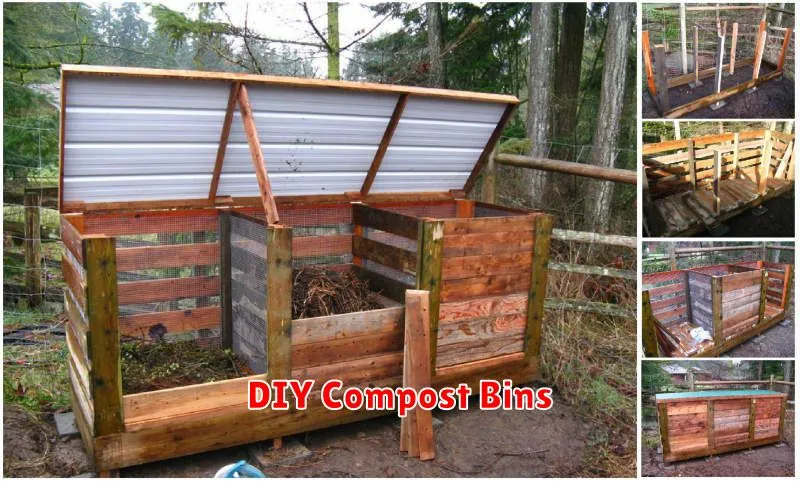
Creating a DIY compost bin is a rewarding and environmentally friendly way to enrich your garden soil. Several simple designs are achievable using readily available materials, from repurposed pallets and old barrels to custom-built structures from wood. The key is ensuring adequate ventilation and a balance of “green” (nitrogen-rich) and “brown” (carbon-rich) materials.
Choosing the right materials is crucial for both aesthetics and functionality. Wood offers a natural look and good durability, while plastic bins provide a more weather-resistant option. Consider the size of your garden and the volume of compostable waste you generate when determining the dimensions of your bin. Proper placement is also important; selecting a shady, easily accessible location will facilitate the composting process.
Maintaining your compost bin involves regular turning to aerate the mixture and monitoring moisture levels. A well-maintained bin should produce rich, dark compost within a few months. This valuable addition to your garden will improve soil structure, increase water retention, and provide essential nutrients for healthy plant growth, making it a truly sustainable gardening solution.
Vertical Herb Walls

Vertical herb walls offer a space-saving and aesthetically pleasing solution for incorporating fresh herbs into any garden design. These structures, often constructed from modular systems or repurposed materials, allow for the vertical cultivation of a variety of herbs, maximizing the use of limited space. The design flexibility permits customization to fit different garden styles and sizes.
Planting options range from individual herb pots within a structured wall to hydroponic or soil-based systems. Proper planning, including consideration of sunlight exposure, water drainage, and herb selection, is crucial for success. Careful attention to these factors will ensure thriving herbs and a visually appealing vertical garden feature.
Beyond their practicality, vertical herb walls provide a unique visual element to any landscape. They offer a textural contrast and introduce vibrant greenery, enhancing the overall aesthetic appeal of the garden. The ease of access to fresh herbs adds to the functionality and enjoyment of this creative landscaping project.
Recycled Wood Garden Benches
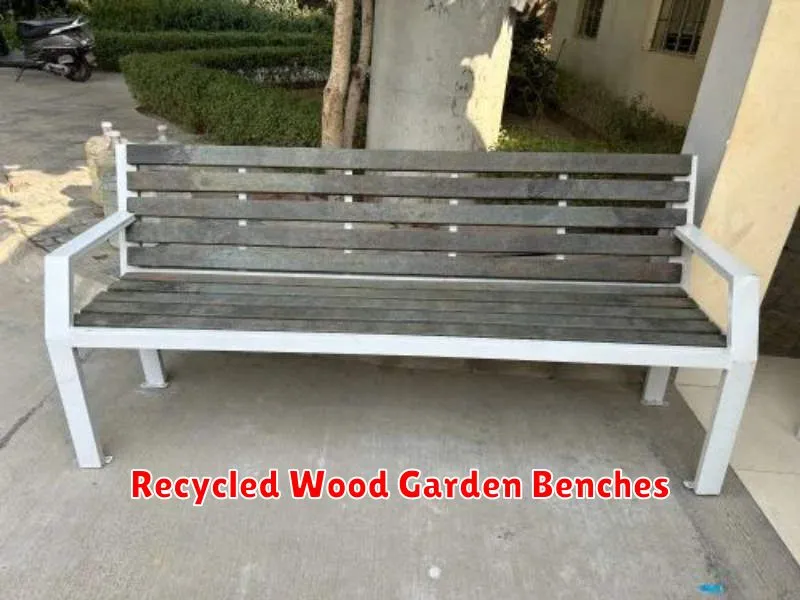
Recycled wood garden benches offer a sustainable and aesthetically pleasing addition to any garden landscape. Using reclaimed lumber, such as pallets or old fence posts, significantly reduces waste and provides a unique character to your outdoor space. The inherent variations in color and texture contribute to the bench’s rustic charm, creating a focal point that complements natural surroundings.
Construction of a recycled wood bench is often straightforward, making it a feasible DIY project. Depending on the chosen wood, minimal preparation may be required before assembly. However, proper cleaning and treatment with weather-resistant sealant is crucial for longevity and to prevent rot and insect infestation. This ensures the bench remains durable and functional throughout the seasons.
The design possibilities are extensive; from simple, straight-backed benches to more elaborate curved seating, the options are limited only by your creativity and the available materials. Incorporating other reclaimed materials, such as metal brackets or salvaged stone, can further enhance the bench’s unique appeal and seamlessly integrate it into the overall garden design. The result is a beautiful and environmentally conscious addition to your outdoor living area.
Climbing Plant Trellises

Climbing plant trellises offer a versatile and aesthetically pleasing solution for enhancing garden landscapes. They provide vertical support for climbing plants, maximizing space utilization and creating stunning visual effects. The choice of trellis design can significantly impact the overall garden aesthetic, ranging from simple, rustic designs to more ornate and elaborate structures.
The material used for the trellis is a key consideration. Options include wood, metal, bamboo, and even recycled materials, each offering distinct advantages in terms of durability, style, and maintenance requirements. The size and shape of the trellis should also be carefully planned to suit the specific climbing plant and its growth habit, ensuring adequate support and preventing overcrowding.
Beyond their practical function, trellises can be integrated creatively into the garden design. They can be used to define spaces, create focal points, or camouflage unsightly areas. Strategic placement can also enhance the overall composition, leading to a more balanced and visually appealing garden. Consider incorporating diverse climbing plants with varying textures, colors, and flowering periods to maximize the trellis’s visual impact.
Weather-Resistant Outdoor Rugs

Weather-resistant outdoor rugs offer a stylish and practical solution for enhancing your garden landscaping. They provide comfort underfoot on patios and decks, while also protecting the surface from wear and tear. Choosing the right material, such as polypropylene or solution-dyed acrylic, is crucial for ensuring longevity and resistance to fading, mildew, and moisture.
Beyond their practical benefits, these rugs add a significant design element to your outdoor space. A wide variety of colors, patterns, and textures are available, allowing you to seamlessly integrate the rug into your overall garden aesthetic. Consider the size and placement carefully to maximize their impact and create visually appealing zones within your landscape.
Proper maintenance is key to extending the life of your outdoor rug. Regular sweeping or vacuuming will remove dirt and debris. For more thorough cleaning, many weather-resistant rugs can be hosed down or even machine washed, depending on the manufacturer’s instructions. With careful selection and maintenance, a weather-resistant outdoor rug can be a beautiful and durable addition to your garden for years to come.

